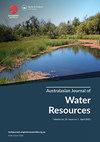How well is the basin plan meeting its objectives? From the perspective of the Coorong, a sentinel of change in the Murray-Darling Basin
IF 2.2
Q2 WATER RESOURCES
引用次数: 1
Abstract
ABSTRACT Freshwater aquatic ecosystems can be considered sentinels of change as they integrate signals from catchment, hydrology and biogeochemistry to provide an indication of how the system fluctuates. The Coorong estuary acts as a sentinel for the Murray-Darling Basin (MDB), Australia. Its location at the terminus of the Murray-Darling River systems, which drains more than 1 million square kilometres across 22 major catchments, means that any change to climate, water extraction or land use in the upstream catchments will have repercussions for the Coorong. It therefore acts as an indicator of the health of the MDB and the effectiveness of the Murray-Darling Basin Plan at protecting this ecosystem. Environmental water secured through the Murray-Darling Basin Plan and establishment of the Commonwealth Environmental Water Holder has been critical to preventing significant ecosystem decline in the Coorong. For most water years in the last decade environmental water has contributed to the majority of flow through the barrages. This has exported salt from the basin, reduced influx of salt from the ocean, and expanded available habitat for fish in the Coorong. However, the environmental flows have not been sufficient to arrest sand build up, and dredges still operate at the Murray Mouth during all but the highest flow events. There is a clear case for continued water management and reform, extending beyond the boundaries of the MDB, to further increase security of water flowing along the river system through the barrages and supporting the ecological health of the Coorong, and by association the full MDB.流域计划实现其目标的情况如何?从墨累-达令盆地变化的哨兵库荣的视角
本文章由计算机程序翻译,如有差异,请以英文原文为准。
求助全文
约1分钟内获得全文
求助全文
来源期刊

Australasian Journal of Water Resources
WATER RESOURCES-
CiteScore
5.10
自引率
21.90%
发文量
25
期刊介绍:
The Australasian Journal of Water Resources ( AJWR) is a multi-disciplinary regional journal dedicated to scholarship, professional practice and discussion on water resources planning, management and policy. Its primary geographic focus is on Australia, New Zealand and the Pacific Islands. Papers from outside this region will also be welcomed if they contribute to an understanding of water resources issues in the region. Such contributions could be due to innovations applicable to the Australasian water community, or where clear linkages between studies in other parts of the world are linked to important issues or water planning, management, development and policy challenges in Australasia. These could include papers on global issues where Australasian impacts are clearly identified.
 求助内容:
求助内容: 应助结果提醒方式:
应助结果提醒方式:


